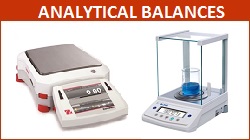How Accurate Are Analytical Balances?Posted by Global Lab Supply on December 15th, 2018 How accurate are analytical balances?Reliable results with accurate weighing by analytical balances also useful to measure small mass in the sub-milligram range Analytical balances are greatly sensitive lab instruments designed to perfectly measure mass. Their read-capacity has a range between 0.1mg - 0.01mg. Analytical balances require monitoring cautiously as well as calibrated frequently. Most analytical balances have both automatic internal motorized calibration as well as calibration with external weights. Analytical balances have a weighing chamber or draft shield to safe the very small samples from being affected by air currents. This enclosure is often called a draft shield. The utilization of a mechanically vented balance protection enclosure, which has exclusively designed acrylic airfoils, allows a smooth turbulence-free airflow that stop balance fluctuation as well as the measure of mass down to 1 μg without loss or fluctuations of product. Also, the sample should be at room temperature to stop natural convection from forming air currents inside the enclosure from causing an issue in reading. They're meant to detect very well increments, so the slightest vibrations or breeze may impact the results. As such, analytical balances should be utilized in a separated area with as no any disturbances as possible. An analytical balance is also well-known as lab balance is a class of balance developed to measure small mass in the sub-milligram range. The measuring pan of an analytical balance (0.1 mg or better) is inside a transparent enclosure with doors so that dust does not collect as well as so any air currents in the room do not control the balance's operation. Single pan mechanical substitution balance maintains consistent response throughout the helpful capacity is achieved by managing a constant load on the balance beam, thus the fulcrum, by subtracting mass on the similar side of the beam to which the sample is added. Electronic analytical scales measure the force required to counter the mass being measured rather than using actual masses. As such they should have calibration adjustments made to compensate for gravitational differences. They utilize an electromagnet to generate a force to counter the sample being measured and outputs the result by measuring the force required to achieve balance. Such measurement device is considered electromagnetic force restoration sensor. There are several significant parts to an analytical balance. A beam arrest is a mechanical device that prevents harm to the delicate internal devices when objects are being placed or eliminate from the pan. The pan is the area on a balance where a sample is placed to be weighed. Leveling feet are modifiable legs that ensure the balance to be brought to the reference position. The reference position is determined by the spirit level, leveling bubble, or plumb bob that is an essential part of the balance. Analytical balances are so sensitive that still air currents may also affect the measurement. To protect against this they should be sheltered by a draft shield. This is a glass or plastic enclosure with doors that ensures access to the pan. Usually capacity for an analytical balance ranges from 1 g to a few kilograms with precision as well as accuracy often exceeding one part in 106 at completes capacity. Author Bio -: Global Lab Supply is an expert in the field of Lab Equipment & Analytical Instruments. Get any type of electronic analytical balance and more information about the Analytical Balancesvisit Globallabsupply.com. Like it? Share it!More by this author |



